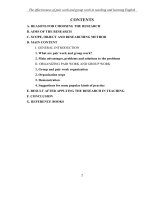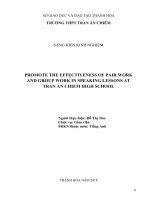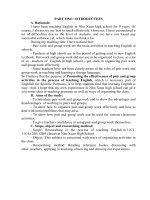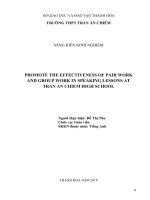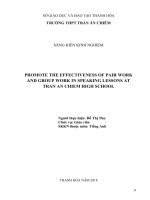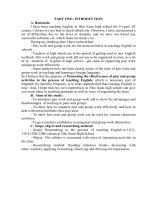(SKKN mới NHẤT) PROMOTING THE EFFETIVENESS OF USING PAIR AND GROUP WORK IN SPEAKING AT HIGH SCHOOL
Bạn đang xem bản rút gọn của tài liệu. Xem và tải ngay bản đầy đủ của tài liệu tại đây (586.61 KB, 20 trang )
Sáng kiến kinh nghiệm
Vũ Thị Oanh
SỞ GIÁO DỤC VÀ ĐÀO TẠO THANH HÓA
Sáng kiến kinh nghiệm
Phát huy hiệu quả hoạt động cặp, nhóm
trong q trình dạy học tiếng Anh
ở trường THPT
Người viết:
:
Tổ
Trường
:
Năm học:
Vũ Thị Oanh
Ngoại Ngữ
THPT Thiệu Hóa
2017- 2018
1
download by :
Sáng kiến kinh nghiệm
Vũ Thị Oanh
CONTENTS
A. REASONS FOR CHOOSING THE RESEARCH
B. AIMS OF THE RESEARCH
C. SCOPE, OBJECT AND RESEARCHING METHOD
D. MAIN CONTENT
I. GENERAL INTRODUCTION
1. What are pair work and group work?
2. Main advantages, problems and solutions to the problems.
II. ORGANIZING PAIR WORK AND GROUP WORK
1. Group and pair work organization.
2. Demonstration.
3. Suggestions for some popular kinds of practice.
E. RESULT AFTER APPLYING THE RESEARCH IN TEACHING
F. CONCLUSION
G. REFERENCE BOOKS
2
download by :
Sáng kiến kinh nghiệm
Vũ Thị Oanh
A. REASONS FOR CHOOSING THE RESEARCH
- Pair work and group work are the main activities in teaching English
at schools.
- Teachers at high schools are in the period of getting used to new
English textbook. Pair work and group work didn’t use to be organized in
class, so a lot of us – teachers of English at high school – get stuck in
organizing pair work and group work effectively.
- Some teachers haven’t been clearly aware of the roles of pair work
and group work in teaching and learning a foreign language.
B. AIMS OF THE RESEARCH
- To introduce pair work and group work and to show the advantages
of working in pairs and groups.
- To show how to organize pair and group work effectively and how
to deal with initial problems that may arise.
- To show how pair and group work can be used for various classroom
activities.
- To give teachers confidence in using pair and group work
themselves.
C. SCOPE, OBJECT AND RESEARCHING METHOD
- Scope : Researching in the process of teaching English at Ngoc Hoi
high school.
- Object: This subject is concerned with ways of organizing activities
in the class.
- Researching method: Reading reference books , discussing with
other teachers, applying in teaching, observing and drawing out experiences.
D. CONTENT
I. GENERAL INTRODUCTION
1. What are pair work and group work?
1.1. Pair work:
The teacher devices the whole class into pairs. Every student works
with his or her parner and all the pairs work at the same time. The teacher
walks around, listens and intervenes little if necessary.
1.2 Group work :
Students work in small groups (of four or five) on tasks that entail
interaction: conveying information, for example, or group decision making.
3
download by :
Sáng kiến kinh nghiệm
Vũ Thị Oanh
All the groups work at the same time. The teacher walks around listening,
intervenes little if at all
2. Main advantages, problems and solution to the problems.
For certain types of activity, pairwork and groupwork have number of
advantages over working with the whole class together. Teachers should
think what the main advantages are, and also what problems might be
involved in pairwork, groupwork and the solutions for these.
Here are some main advantages and problems:
Advantages
More language practice
Students are more involved
Students feel secure, confident
Students help one another
Save time
Problems
Noise
Students make mistakes
Difficult to control
…………………..
( Of course, your own advantages and problems may look slightly different
from these, but most teachers suggestions will probably fit under these
headings)
Now, we will discuss each heading in more detail. First, let’s start with the
advantages
*More language practice:
Pairwork and groupwork give students far more chance to speak
English. For example, students are given an exercise of making sentences
(question & answer), working in pair, each student makes as many sentences
as they can. If the exercise were done ‘round the class’, students would only
say one sentence each , and in a large class many students would say nothing
at all.
* Student are more involved:
Some activities will probably be dominated by a few students and
others would lose interest if they are conducted with the whole class
together. Working in pairs or groups encourages students to be more
involved and to concentrate on the task.
* Students feel secure:
Students feel less anxiety when they are working privately than when
they are on show in front of the whole class. Pairwork and groupwork can
help shy students who would never say anything in a whole class activity.
4
download by :
Sáng kiến kinh nghiệm
Vũ Thị Oanh
*Students help each other:
Pairwork and groupwork encourage students to share ideas and
knowledge. In a reading actictivity, students can help each other to explore
the meaning of a text; in a discussion activity, students can give each other
new ideas.
Now talk about the problems, and discuss the ways of recovering them:
* Noise:
Obviously pairwork and groupwork in a large class will be noisy, and
this can not be helped. But:
- Usually the students themselves are not disturbed by the noise; it is
more noticeable to the teacher standing at the side or to someone in the next
room .
- The noise created by pairwork and groupwork is usually “good”
noise. Students use English or engage in a learning task. Teacher should stop
the activity when most groups or pairs have finished or prepare a “reserve”
task to occupy members of groups who finish earlier than expected.
* Students make mistakes:
During a pair or group activity, the teacher can not control all the
language used, and should not try to do so. When doing cotrolled language
practice in pairs or groups, the number of mistakes can be reduced by:
- Giving enough preparation, the activity can be done with the whole
class first, and pair work used for final stage.
- Checking afterwards. The teacher can ask some pairs or groups what
they said , and then correct mistakes if necessary.
*Difficult to control class:
The teacher has less control over what students are doing in
pairwork and groupwork than in normal class. To stop activities getting out
control, it is important to:
- Give clear instructions about when to start, what to do and when to
stop.
- Give clearly defined tasks which don’t continue for too long.
- Set up a routine, so that students accept the idea of working in pairs
or groups, and know exactly what to do.
5
download by :
Sáng kiến kinh nghiệm
Vũ Thị Oanh
II. ORGANIZING PAIR WORK AND GROUP WORK
1. Group and pair work organization
- The success of group or pair work depends on some extents:
The surrounding social climate .
How habituated the class is to using it
The selection of an interesting and stimulating task whose
performance is well within the ability of the group or pair.
- More immediately, it also depends on:
Effective and careful organization.
2. Organization steps:
2.1. Presentation:
The instructions that are given at the beginning are crucial. If the
students do not understand exactly what they have to do, there will be timewasting, confusion, lack of effective practice, possible loss of control. Select
tasks that are simple enough to describe easily; and in monolingual classes,
you may find it cost-effective to explain some or all in the students’mother
tongue. It is advisable to give the instructions before giving out materials of
dividing the class into groups; and a preliminary rehearsal or ‘dry run’ of a
sample of the activity with the full class can help to clarify things. If your
students have already done similar activities, you will be able to shorten the
process,giving only brief guidelines;It is mainly the first time of doing
something with a class that such care needs to be invested in instructing.
Try to foresee what language will be needed, and have a preliminary
quick review of appropriate grammar or vocabulary. Finally before giving
the sign to start tell the class what the arrangements are for stopping: If there
is a time limit, or a set signal for stopping, say what it is; if the groups
simply stop when they have finished, then tell them what they will have to
do next. It is wise to have a reserve task planned to occupy members of
groups who finish earlier than expected.
2.2. Process:
Teacher goes from group to group, pair to pair, monitor, and either
contribute or keep out of the way whichever is likely to be more helpful. If
you do decide to intervene, your contribution may take the form of :
- Providing general approval and support;
- Helping students who are having difficultly;
- Keeping the students using the target language(in many cases your
mere presence will ensure this!)
- Tactfully regulating participation in a discussion where you find
some students are over dominant and others silent.
6
download by :
Sáng kiến kinh nghiệm
Vũ Thị Oanh
2.3. Ending:
Draw the activity to a close at a certain point. Try to finish the activity
while the students are still enjoying it and interested, or only just beginning
to flag.
2.4. Feedback:
A feedback session usually takes place in the context of full-class
interaction after the end of the group work. Feedback on the tasks may take
many forms:
- Giving the right solution, if there is one.
- Listening to and evaluating suggestions.
- Pooling ideas on the board.
- Displaying the meterials the groups/ pairs have produced.
And so on.
The main objective here is to express appreciation of the effort that
has been invested and its results. Feedback on language may be integrated
into this discussion of the task, or provide the focus of a separate class
session later.
3. Demonstration:
3.1. Example of pair work:
Example 1:
A teacher has an intermediate class. She presented “like/don’t like”
and then she uses this exercise for free practice in pairs:
Exercise 3: Likes and dislikes
Pairwork : Ask what your friend likes and doesn’like
Ask about:
Food
Clothes
Sport
School subjects
- Things the teacher did before , during and after the activity.
Before: Teacher says “All right. Exercise 3. Work in pairs; ask and
answer the questions”
During: Teacher sit at one place and says nothing.
After: Teacher says “ Everyone finished? Good. Now look at exercise
4 …….”
- Some question for us:
Do you think the activity was successful?
What do you think might have gone wrong?
What could she do to make it more successful?
*Discuss why the activity was not successful , and what the teacher could
do to make it more successful:
7
download by :
Sáng kiến kinh nghiệm
Vũ Thị Oanh
- She could prepape for the pairwork by establishing what the
questions and answers should be. She could also demonstrate the pairwork
by asking questions round the class, or by getting one pair of students to ask
and answer in front of the class. Then students would know exactly what to
do.
- She could be more active in starting the pairwork. Instead of just
saying ‘work in pairs’, she could show students who to work with, check
that everyone had started working in pairs. This would be very important if
the class were not used to pairwork.
- During the activity, she could move quickly round the class to check
that students were talking and to see when they finished.
- Instead of waiting for everyone finished , she could stop the
activity. Then there would be no chance for students to get bored and start
talking about other things.
- After the pairwork, she could ask some pairs what they said, or ask a
few pairs to repeat their conversation in front of the class.
Example 2:
Teacher presented “used to /didn’t use to + inf (Unit 4, part E –
language focus) and then used the following exercise for free practice in
pairs.
Exercise: Work in pairs, ask what your friends used to do and didn’t
use to do (Ask about food, sport, music, school, subject ……. ).
A possible procedure:
* Introduce the exercises and show what questions and answers students
can give:
Teacher: Now you are going to talk about things you used to do and things
you didn’t use to do. Look at the exercise. What question can you ask?
What about food?
Student A: What food did you use to eat when you were small?
Student B: I used to eat ice – cream.
(And so on)
*Write the basic question on the board:
What (food) did you use to eat?
*Ask a few questions round the class to show the kind of conversation
students might have:
Teacher: What kind of music did you use to listen, Huong?
Student: I used to listen to pop music.
Teacher: Pop music? when did you use to listen to it?
( And so on)
8
download by :
Sáng kiến kinh nghiệm
Vũ Thị Oanh
If teacher likes, ask two students to have similar conversations, while
the others listen.
* Divide the class into pairs:
Teacher: Now. You’re going to work in pairs (Indicate by pointing. If there
are single students left without a partner, make groups of three). Ready? Ask
and answer the questions. First, one person asks all the questions then
change round. Start now.
* Students work in pair. Teacher moves quickly round the class,
checking that everyone is talking (but do not try to correct mistakes, as
this will interrupt the activity)
* When most pairs have finished, stop the activity. Ask a few students
what their partners said:
Teacher : Now, stop talking. Mai, tell me about Huong. What did she used to
do?
Student : She says she used to eat ice cream, listen to pop music and swim in
the afternoon , she liked meat but she didn’t use to eat it. She was afraid of
being overweight
* Give feedback
- Well done.
- Pay attention to….
(And so on)
3.2. Example of group work.
Task 4 (Unit 5 – Part B: Speaking - English 10)
This is a free activity and aims to develop fluency in speaking. The
procedure may be:
Divide students into groups of four or five.
Read through the instrutions and make sure that each group
understands what to do. Choose one “secretary” in each group to write the
list but emphasis that everyone in the groups should agree on what to write.
While the activity is going on, move from groups, but do not interrupt
more than is necessary.
When some groups have finished their discussion, stop the activity,
ask one person from each group to report on what they decided
Give feedback: - Content
- Popular mistakes
3.3. Example of dividing the class:
First, draw a plan of your own class of 50 students. Show how you
would divide the class for a pair work or a group work activity and what
instructions you would give :
9
download by :
Sáng kiến kinh nghiệm
Vũ Thị Oanh
Here are two rows of a class of 50 students. The desks are fixed and
the students sit on chairs.
1
2
4
3
5
6
7
8
10
11
9
12
13
For pair work: Most students could work with the person next to
them. Student 6 could turn round and work with student 3 and students 7, 8,
and 9 work as three together. Or student 3 could move to work with student
4 and the second row could be divided into two pairs and one three.
For group work: Students could work in threes and fours along each
row. This would be easy to organize but would make it difficult for students
to work well as a group, as they would be in a straight line. Or Students in
the first row could turn round and form groups with those behind.
The first few times that you try pair or group work, you need to give
careful instructions and know exactly how you will divide the class. Pair
work and group work can become a routine. Once students are used to it
and have regular working partners, it can be organized quickly and easily.
4. Suggestions for some popular kinds of practice
Pairwork and groupwork are not “teaching methods”, but ways of
organizing the class. They can be used for many different kinds of activity,
and are naturally more suitable for some activities than for others. Before
deciding what kind of activity will be used teacher should answer the
following questions:
- Could you use pairwork or groupwork for part of the activity?
- If so, exactly what would students do in pairs or groups?
- What would you need to do before the pair /group stage?
- Is there anything you would do after it?
- Is there anything you would do after it?
Here are suggestions for some popular kinds of practice:
*Pattern practice:
This can be done in pairs in the same way as practicing structure with
“used to” mentioned in part 2 - Demonstration. Any controlled oral practice
can be done first with the whole class, and then in pairs.
10
download by :
Sáng kiến kinh nghiệm
Vũ Thị Oanh
* Practising short dialogues:
Acting out short dialogues can very easily be done in pairs, with little
chance of making mistakes. It can be done first with pairs of students in
front of the class and then with all students working in pairs at the same
time.
* Reading a text and answering questions:
Students can disscuss questions in pairs or groups and then read the
text or they can read the text silently and then ask and answer questions in
pairs or groups. This is a good way of involving the whole class in
answering questions.
* Short-writing exercises:
Student can sit in groups and decide together what to write. One
student acts as “secretary”. This can be difficult to organise but in a large
class it has the advantages that students correct each others’mistakes and the
teacher only has a few papers to mark at the end.
Pair work can be used for correcting written work (eg: homework)students sit in pairs and correct what their partner has written.
* Discussions:
With more advanced class, discussions can be conducted in group. It
is important to define the discussion clearly and to ask each group to report
their conclusions afterwards.
* Grammar exercises:
Student can do grammar exercises orally in pairs; the teacher goes
throught the answers afterwards with the who class and students write the
exercises for homework. This is more interesting and productive than
students doing exercises alone, in silence.
E. APPLYING THE RESEARCH IN TEACHING
UNIT 8: THE STORY OF MY VILLAGE
Lesson 2: Speaking
I. Objectives: By the end of the lesson, students will be able to talk about
plans and their possible results.
IV. Anticipated problems:
- There are some new words.
- Students usually know one way to raise plans Teacher can ask them to
use different ways to talk.
11
download by :
Sáng kiến kinh nghiệm
Vũ Thị Oanh
III. Teaching aids: Pictures, textbook, tapes, projector.
IV. Procedure:
Teacher’s activities
* Warm-up: (3 minutes)
Fill in each gap with one missing letter to make meaningful
words
1. RO-D
2. BRI-G3. SCH- -L
4. FO-TB-LL GR-UND
5. M-DIC-L C-NT-E
- Asks the fastest one to write the answers on board.
- Give the keys.
1. ROAD
2. BRIDGE
3. SCHOOL
4. FOOTBALL GROUND
5. MEDICAL CENTRE
I. Pre-speaking: ( 3 minutes)
- Shows a picture of Ha Xuyen village.
Students’ activities
- Students do in groups of three
or fours.
- Others look at the screen and
correct
- Asks students to look at the pictures and suggestion to talk about - Discuss in pairs
- Take turns to talk about Ha
Ha Xuyen village.
Xuyen village.
1. The road is narrow.
2. The school is small and poor.
3. There is no bridge in Ha
Xuyen village.
4. There is no medical centre in
Ha Xuyen village.
5. There is no football ground in
Ha Xuyen village.
Road/ narrow
12
download by :
Sáng kiến kinh nghiệm
Vũ Thị Oanh
School/ small and poor
+ There/ no bridge/ in Ha Xuyen village.
+ There/ no medical centre/ in Ha Xuyen village.
+ There/ no football ground/ in Ha Xuyen village.
- Raises the question:
What should we do to improve the life in the village?
- Leads in new lesson: Let’s practice talking about the plans to
improve the life in Ha Xuyen village and their possible results.
II. While-speaking: (30 minutes)
Task 1: (5 minutes) The villagers of Ha Xuyen are discussing
plans to improve the life in the village. Look at the pictures and
say what they should do.
- Ask sts to practise in pairs before presenting in front of the class.
- Practise speaking in pairs
- Take turns to talk .
Now
They should widen the road.
13
download by :
Sáng kiến kinh nghiệm
Vũ Thị Oanh
In the future
Now
They should build a new school.
In the future
Now
They should build a new bridge.
14
download by :
Sáng kiến kinh nghiệm
Vũ Thị Oanh
In the future
They should build a medical
centre.
In the future
They should build a football
ground
In the future
- Supposes students are Ha Xuyen villagers, give a model:
15
download by :
Sáng kiến kinh nghiệm
Vũ Thị Oanh
A: What should we do to improve the life in the
village?
B: I think we should widen the road
- Gives more suggestion and asks students to produce the similar
conversations.
+ Widen the road
+ Build a new school
+ Build a bridge
+ Build a medical centre
+ Build a football ground
Task 2: ( 2 minutes)
Match each of the plans with its possible result
- Raise some plans and possible results:
* Plans:
1. Resurface the road
2. Build a medical centre
3. Build a football ground
4. Grow cash crops
5. Build a bridge
6. Build a new school
* Possible results:
a. Children will have better learning conditions; they will be more
interested in learning.
b. Villagers will have a shorter way to town; cars and lorries can
get to the village.
c. People’s health will be looked after better; the sick will be
cured in time.
d. Young people can play sports; people can hold festival there.
e. People can export the crops; they will have more money.
f. Roads will not be muddy and flooded after it rains; people can
get around more easily
- Presents new words.
* Match each word with its Vietnamese equivalent
Words
Vietnamese equivalents
1. Flooded
a. Trải lại (mặt đường)
2. Cure
b. Lầy lội
3. Export
c. Bị ngập lụt
4. Muddy
d. Xuất khẩu
5. Resurface
e. Chữa trị
- Asks one student to write the answers on board
- Give the keys.
* Keys: 1-c; 2-e; 3-d; 4-b; 5-a
- Asks students to match each of the plans with its possible result
- Show the keys and correct the answers on board.
- Read the model in chorus.
- Practice in pairs
- Read the plans and results to
find out new words.
- Work in pairs.
- Look at the screen to correct
- Copy then read the new words
in chorus.
16
download by :
Sáng kiến kinh nghiệm
Vũ Thị Oanh
* Keys: 1-f; 2-c; 3-d; 4-e; 5-b; 6-a
Task 3: ( 2 minutes)
Produce conversations in groups of three or four
- Gives model:
A: What should we do to improve the life in the village?
B: I think we should resurface the roads
C: That’s a good idea. If we resurface the roads, they won’t
be muddy and flooded.
D: Yes. And people can get around more easily
- Lets students produce conversations in groups.
- Asks some groups to present in front of the class.
IV. Post-speaking: ( 7 minutes)
- Gives question relate to the fact
What should we do to improve our English?
- Read the model in group of
four.
- Work in groups
- Look at the pitures and
suggestion to ask and answer in
pairs.
A: What should we do to
improve our English?
B: We should practice English
everyday.
Practice English everyday
A: What should we do to
improve our English?
B: We should speak to
foreigners.
Speak English to foreigners
17
download by :
Sáng kiến kinh nghiệm
Vũ Thị Oanh
A: What should we do to improve
our English?
B: We should listen to English
tapes
Listen to English tapes
- Gives suggestions and asks students to complete the
conversation.
PLANS
RESULTS
- Practice English everyday
- Get good marks in
- Speak English to foreigners
English.
- Listen to English tapes
- Speak English more
- Read many English books.
fluently
- Widen our English
vocabularies.
- Do English tests better
* Complete this conversation:
A: We are not very good at English.
What should we do to ………………………….?
B: I think we should ………………………………..
C: Yes, if we …………………, we can …………….
D: That’s a good idea.
- Asks two or three pairs to present.
V. Homework: ( 2 minutes)
- Learn all new words by heart then make sentences with them.
- Write four conversations in the notebook
- Prepare new word for listening lesson.
- Work in pairs.
F. RESULT AFTER APPLYING THE RESEARCH IN TEACHING
Students
100%
Excellent-good
35%
Average
60%
Weak (bad)
5%
18
download by :
Sáng kiến kinh nghiệm
Vũ Thị Oanh
G. CONCLUSION:
In group or pair work, learners from a learning task through small
group interaction. Learners in a class that is divided into six groups or 15
pairs get six times or fifteen times as many opportunities to talk as in full
class organization. They also have other advantages: They foster learner
responsibility and independence, can improve motivation and contribute to a
feeling of cooperation and warmth on the class, so that organizing pair work
and group work effectively helps improves learning outcomes.
Thieu Hoa, May 20th 2018
Signature
Vũ Thị Oanh
Teacher of English at Thieu Hoa high school
19
download by :
Sáng kiến kinh nghiệm
Vũ Thị Oanh
REFERENCE BOOKS
1. Practical handbook of language teaching (David Cross)
2. A course in language teaching - Practical and Theory (Penny Ur)
Cambrige university press
3. Giao trinh giao hoc phap (Tổ ngoại ngữ –Khoa ngôn ngữ và văn hóa Anh
- Mĩ - Úc – Trường đại học quốc gia Hà Nội)
4.Phương pháp dạy tiếng Anh Trung học phổ thông (Nguyễn Hạnh Dung)
20
download by :




